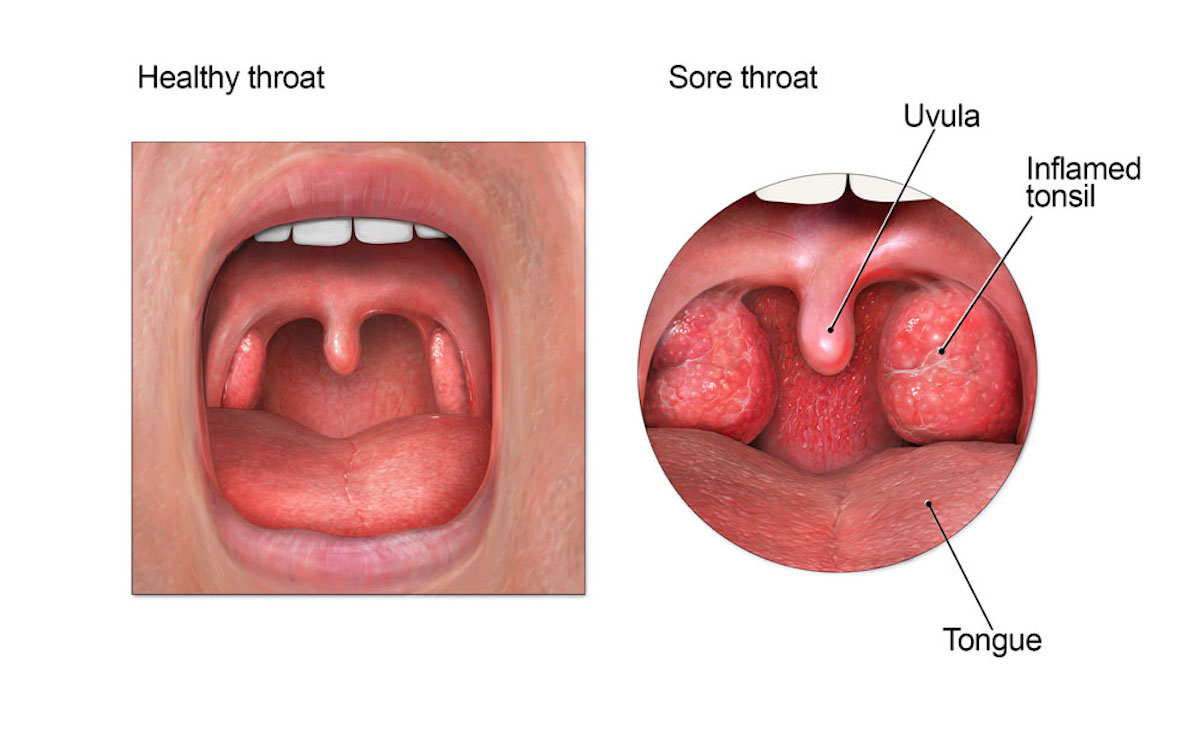Streptococcal pharyngitis (strep throat), is a bacterial infection of the throat and tonsils caused by a group A streptococcal infection. All age groups can be affected by this bacterium. In fact, 1 in 10 disorders of the throat area is caused by streptococcal bacteria. Throat infection is highly contagious, so it is important that you know the symptoms that indicate you’re suffering from the disease so that you do not infect others. To rule out viral infection or chronic bronchitis, taking a throat culture – also known as a strep test – is necessary. You should see your doctor as soon as possible if you develop any of the following symptoms.

Most Common Strep Throat Symptoms
Sore Throat
Sore throat is one of the main symptoms of streptococcus. This can be a mild to a severe symptom. Normally, the sore throat starts about five days after exposure to the bacteria. If you suffer from a sore throat, there are a few things you can do to relieve the discomfort. One option is to use a throat sweetener or cough syrup, both of which can help to soothe and relieve the pain. Honey can also be helpful in this regard. Another option is inhaling steam, which can help reduce the inflammation that causes the pain.
Red Throat
One way you can tell the difference between strep throat and other causes of sore throat is if the throat appears red on inspection. The throat may look red, and it may also have light spots on it. This can also be seen in the tonsils, which may be inflamed and swollen. If you can’t assess this yourself, ask a loved one to check the back of your throat and use a teaspoon to keep your tongue flat and out of the way.
Difficulty Swallowing
If the symptoms of laryngitis are very severe, you may have difficulty swallowing. This is caused by inflammation in the throat and the tonsils, making it difficult to pass things – including food. If swallowing hurts a lot and takes a lot of effort, then streptococcus may be the cause. Try to eat food in small amounts and choose soothing, soft foods like yogurt, fruit smoothies, and soups to make it easier to swallow.
As mentioned, one of the challenges with sore throats is determining whether it is indeed the cause of the sore throat or whether a viral infection or other irritation may be responsible. One way to find out is to look at the duration of the symptoms. With strep throat, the symptoms of a sore throat are usually more severe and prolonged. This can last for several weeks. If you have a “common” cold or viral infection, the sore throat is more likely to pass after a day or two.

No Runny Nose
If you have a cold or the flu, you will notice a number of other symptoms that particularly target the sinuses. For example, you may experience a runny nose, runny eyes, or congestion. With laryngitis, the condition is much more focused on the throat itself, so those other symptoms are less common. You may experience congestion and mucus in the throat itself, but the nose is less likely to be affected.
Loss of Voice
Loss of voice is a common side effect of strep throat. Your throat may hurt a lot when you talk. There may also be problems using the tonsils and passing air through the windpipes. As a result, your voice will crack, be very faint, and be painful when talking. In either case, you will prefer to remain silent and have to mime to let people know what you are thinking. Try to give your voice as much rest as possible to avoid further irritation.
Swollen Lymph Nodes
Another common side effect of strep throat is that your lymph nodes become inflamed. Your lymph nodes are natural detoxifiers located around the body that can help remove unwanted toxins and pollutants from your blood. These too can become inflamed and infected, causing them to swell. To find the lymph nodes, feel with your fingers on either side of your jaw, just below your neck. If they feel swollen, it’s a sign that you may have streptococcus.
Fever
Any kind of infection can cause a rise in temperature because this is one way the body reacts and tries to expel the unwanted bacteria. In this case, the body raises the temperature to make the environment less hospitable to bacteria. A sudden fever of 38 degrees or higher is a common sign of strep throat when it occurs in addition to the sore throat and other symptoms. However, keep in mind that not every case of strep throat is accompanied by a fever.

Peritonsillar Abscess
If left untreated, strep throat may cause laryngitis that may spread through the throat and esophagus and potentially cause complications in other tissues and organs in the throat. A condition that may develop as a result of streptococcal bacteria is a peritonsillar abscess. This is an abscess that forms at the front of the tonsil and is made up of a collection of bacteria. It typically appears two to eight days after the onset of a sore throat and may be accompanied by additional pain in the throat, a throbbing sensation, and swollen glands.
Rash
Having a rash when you have strep throat may be a sign of scarlet fever, a bacterial infection caused by group A Streptococcus bacteria. The rash is typically red and may feel like sandpaper to the touch. It usually begins on the neck and face and spreads to the rest of the body. In addition to the rash, other symptoms of scarlet fever may include a high fever, a sore throat, headache, nausea, vomiting, and swollen lymph nodes. It is important to seek medical attention if you or your child has symptoms of scarlet fever, as it should be treated by a professional healthcare provider.
Treatment Options for Strep Throat
If the diagnosis is strep throat your professional healthcare provider will set up a treatment plan. Often this consist of oral antibiotics and painkillers, like paracetamol and ibuprofen. You can buy this is the closest pharmacy. Make sure you’re completely informed on the subject, by continuing your online research about strep throat, scarlet fever, more strep throat symptoms, and what possible home remedies can speed up the process of getting better.

